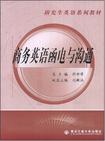商务英语函电与沟通
出版时间:2008-2 出版社:西安交大 作者:郭继荣 页数:238 字数:283000
前言
随着我国对外贸易活动日趋频繁和贸易量的日益增大,外贸英语函电作为外贸活动的主要联系方式之一,其重要性无需置疑;同时,我们发现,在国际商务活动中,除了熟练的外贸函电沟通能力之外,较好地跨文化知识和沟通能力对于外贸工作者也是必不可少的。而这一点正是《研究生英语系列教材·商务英语函电与沟通》有别于市面流行的多数外贸英语函电书的区别。《研究生英语系列教材·商务英语函电与沟通》主要适宜于作为外贸专业或外贸辅修专业学生的教材,也可作为外贸从业人员及业余自修者的学习用书和工具书。 《研究生英语系列教材·商务英语函电与沟通》共14个单元,内容涉及商务书信写作基本原则,建立外贸关系、询价、报盘,回盘,订货,谈判、付款、包装、索赔等不同外贸商谈环节实例及语言的具体运用,同时又介绍了外贸企业常用的几种办公书信的写作。对于具体商务沟通活动中所需要注意的沟通技巧和注意事项,也以文化小贴士的形式附于每个单元之后,并提出了很多切实可行的建议。所以,《研究生英语系列教材·商务英语函电与沟通》既是一本课程教材,同时又可充当个人案头的参考学习材料。 《研究生英语系列教材·商务英语函电与沟通》的特点是: 1.使读者掌握一般商务理念和外贸活动相关词汇。 2.学习一般外贸知识,了解常用外语英语函电格式及写作方法。 3.通过商务外贸基本技能的综合训练,使学生掌握一定的实务操作能力和国际商务沟通能力。 《研究生英语系列教材·商务英语函电与沟通》在结构上呈现出严密的系统性,按照外贸业务协商过程的各个环节的顺序,章节之间紧密相连;此外,书中每个单元之后的文化沟通知识使得《研究生英语系列教材·商务英语函电与沟通》既有同类书籍的长处,同时又独具自己的特色。 《研究生英语系列教材·商务英语函电与沟通》的编写得到了西安交通大学研究生院的立项支持,同时在编写的过程中也得到了西安交通大学外国语学院有关领导的关心和鼓励,在此表示感谢。当然,编者在《研究生英语系列教材·商务英语函电与沟通》的编写过程中参考了国内外专家学者的著作,虽在参考文献中列出了这些著作和作者,但难免有所疏漏,所以,在此向《研究生英语系列教材·商务英语函电与沟通》所参考的所有著作的作者们,致以衷心的感谢。
内容概要
《商务英语函电与沟通》共14个单元,主要内容除了系统介绍商务英语中常用文体的写作和日常办公应用文写作知识外,每个单元还介绍了一些关于外贸商务活动中的礼仪及谈判技巧等内容。通过理论与实务的有机结合,使读者充分理解并掌握在建立外贸关系、询价、谈判、付款、包装、索赔等不同外贸商谈环节的实例及语言的具体运用。同时,又为了满足合资企业工作者的需要,论述和举证了基本的日常商务工作中包括会议记录、备忘录、通知信函、商务报告的撰写方法。 本书不仅可以作为外贸专业学生的教材,也可作为外贸从业人员及业余自修者的学习用书和工具书。
书籍目录
Chapter 1 Fundamentals of Business WritingChapter 2 Inquiry and ReplyChapter 3 Offer and Counter-offerChapter 4 Order and ConfirmationChapter 5 Payment,Shipment,Complaints and ClaimsChapter 6 Business Invitations Letters,BidChapter 7 Thanks LetterChapter 8 Programs and AgendaChapter 9 Everyday Business WritingChapter 10 Business ReportChapter 11 MemorandumsChapter 12 Functional English WritingChapter 13 Agreements and ContractsChapter 14 Personal Business LettersKey to Exercises参考文献
章节摘录
Business Culture Tips Personal Space The way personal space is structured is referred to as proxemics. Personalspace, or distance from other persons is a powerful concept, and research sug-gests it directly relates to our interpretation of the meaning of messages conveyedby the other person. The important aspect of proxemics is that areas very close toour body is usually reserved for people we are intimate with, whereas space fur-ther away from our body is open to persons one is less intimate with. This princi-ple is generally universal. 0——8 inches is intimate space reserved for family and close friends. 18 inches to 4 feet is personal space used in most interpersonal interactions. 4——12 feet is social-consultative space used in more formal interactions. Recognize the boundaries of your personal space and that of others. If youare typical of most Americans, it ranges between 30 and 36 inches. Be prepared,however, not to back up or move away from someone who has a personal spacethat is smaller than your own. Hang in there, take a deep breath, and stand yourground. For most of us, merely the awareness of our personal space is enough toconsciously prompt us to stand firm when speaking with someone. If you have asmaller than average personal space, make sure you keep your distance so thatyou do not intimidate someone who possesses a larger personal space. P.S. Ifyou want to have fun at a social gathering, step inside the personal space bounda-ry of a friend. With some practice, you can back them up around the entire roomwithout them even being aware of what is happening. In US, the standard space between you and your conversation partner shouldbe about two feet. Most U. S. executives will be uncomfortable standing at acloser distance.
编辑推荐
主要适宜于作为外贸专业或外贸辅修专业学生的教材,也可作为外贸从业人员及业余自修者的学习用书和工具书。
图书封面
评论、评分、阅读与下载
用户评论 (总计2条)
- 图便宜和没运费在这里买的。很赞。
- 从望上订购到手到货大概要了10天,书的质量还行,希望当当越办越好!
